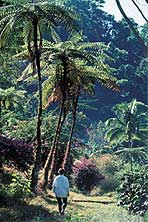| |
|
|
| Private
Nature Reserve |
|
|
|
|
|
In
2001, Los Andes was declared a private nature reserve, and is
a founding member of Guatemala’s Association
of Private Nature Reserves. The unique biodiversity of the Reserve, including
wildlife, has tremendous potential for ecotourism and local residents
are being trained as guides to provide them with an alternate
source of income.
Sixty percent
of the reserve is original forest, most of it along the slopes
of the dormant volcano of Atitlán. Reforestation of
all cleared land not under cultivation has been completed and
will be managed as a sustainable forest for firewood on the
farm to relieve stress on original forest.
To help secure the long term vision of the Reserve,
in 2003 Los Andes was selected by The Nature Conservancy as one
of its pilot projects in the Atitlán area to develop a
sustainable ecological management program that will guide the
family’s conservation efforts well into the future.
|
|
 |
|
|
|
|
|
|
|
|
|
|
|
|
|
|
|
|
|
|
|
|
|
|
|
Los
Andes is a Private Nature Reserve officially registered with
CONAP (National Comission of Protected Areas). Sixty percent
of the estate is a natural cloud forest, habitat to important
birds in danger of extinction, such as the Resplendant Quetzal,
and the Tangara Cabanisis. |
|
|
|
|
|
|
| |
|
|
|
|
|
|
| Present
programs for conservation include artificial nests for the
Quetzales. Hunting
has been prohibited.
We have a reforestation program approved by INAB (The National
ForestryInstitue), as well as eucaliptus forests planted for fire-wood.
Coffee and quinine prunings also supply lumber and firewood. Financial
and technical assistance is provided to buy and install efficient
wood burning stoves in the worker’s houses. As of June 2005,
26 stoves have been installed.
Los Andes has its own hydroelectric plant, that generates all
the power used on the estate. We have also implemented a
system for the separation and appropriate disposal of all
the garbage from the houses on the estate. Energy efficient
stoves are being introduced, as well as composting facilities
at each home for organic waste. |
|
|
|
| |
|
|
|
|
|
|
|